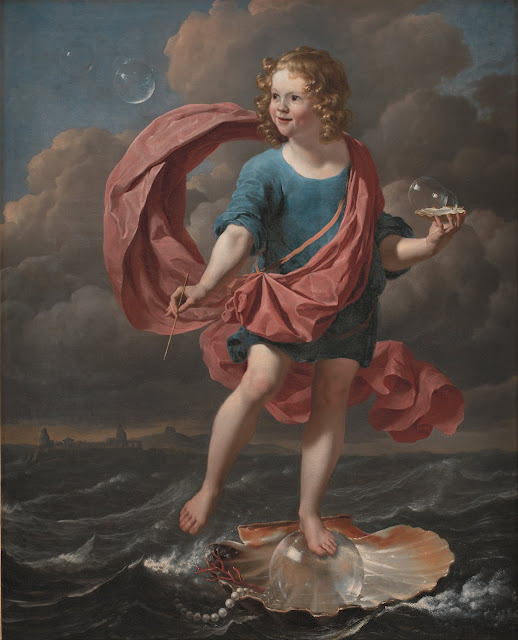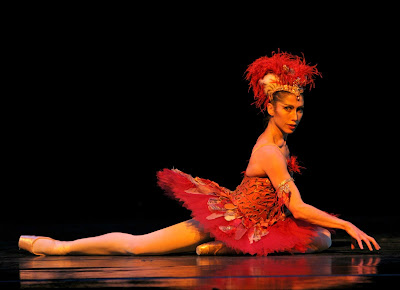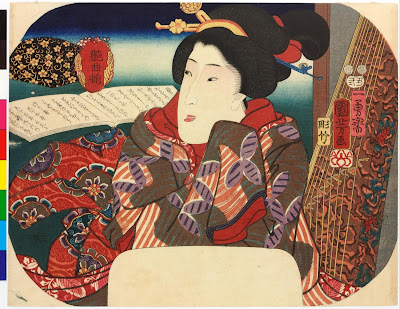allegory is a noun
al·le·go·ry
plural: allegories
1
: the
expression by means of symbolic fictional figures and actions of
truths or generalizations about human existence
a writer known for his use of allegory
also : an instance (as in a story or
painting) of such expression
The poem is an allegory of love and jealousy.
2
: a
symbolic representation
What is the
difference between an allegory and
a metaphor?
Allegory is
the expression of truths or generalizations about human existence by means
of symbolic fictional figures and their actions. It encompasses such
forms as fable and parable. A metaphor,
broadly, is figurative language; specifically, it is a figure of speech in
which a word or phrase literally denoting one kind of object or idea is used in
place of another to suggest a likeness or analogy between them. Aesop’s Fables are an example of allegory; "the ship plows the seas" is an
example of metaphor.
What are
different types of allegory?
Personification allegory is a type of allegory in
which a fictional character represents a concept or a type. The character
Everyman in the medieval play of that name and the Lover in The Romance of the
Rose are figures of personification allegory. Symbolic allegory is one in which
a character or material thing is not merely a transparent vehicle for an idea,
but also has a recognizable identity or a narrative autonomy apart from the
message it conveys. The poet Virgil in Dante's Inferno, a historical figure
representing human reason within the poem, is an example of a symbolic
allegorical figure.
What is the
difference between allegory and simile?
A simile is
a figure of speech in which two unlike things are compared, often introduced
by like or as ("he
had eyes like agates"). Allegory is a
more or less symbolic fictional narrative that conveys a secondary meaning (or
meanings) not explicitly set forth in the literal narrative. Parables, myths,
and fables are all considered types of allegories.
.png)

start here ... with an excellent clarification of what goes on in one of Courbet's most intriguing works ... clicketty-click !
https://smarthistory.org/courbet-the-artists-studio/
Project for a Cartouche: An Allegory of Minerva, Fame, History, and Faith Overcoming Ignorance and Time ... painted by Francois Boucher.
Allegories often involve the PERSONIFICATION of abstract or intangible concepts.
Castiglione's Allegory of Transience ...
https://www.rct.uk/collection/405551/self-portrait-as-the-allegory-of-painting-la-pittura
I wondered if the pendant in Artemisia Gentileschi's self-portrait is an important feature ? It isn't a crucifix. It looks like a mask ... but is it COMEDY ? or is it TRAGEDY ? Is this an understated painting that represents some of her own very human passions and is it a sign of a HUMANISTIC outlook ?
Simon Vouet and Artemisia Gentileschi were great friends. This is his TIME DEFEATED BY HOPE AND BEAUTY from 1627. I have a feeling the models for Hope and Beauty may have been Simon Vouet's lovely new wife and her sister.
.jpeg)
Almost everything that Poussin painted in later life was allegorical, perhaps to suit his clients' needs for a little dignity. Many of his clients were popes and bishops who had their own private passions. Look closely. This painting shows a mythical landscape through which the blinded hunter Orion is guided towards the rising sun ... it is a complicated story in which every figure represents a human or divine trait of some kind ... clicketty click for a possible explanation ...
https://potbanks.wordpress.com/2018/02/01/blind-orion-searching-for-the-rising-sun/
... and some ...
https://www.metmuseum.org/perspectives/videos/2020/5/insider-insights-poussin-orion
... and some more ...
https://fullreads.com/essay/on-a-landscape-of-nicolas-poussin/
Alex Gray was a keen student of anatomy and worked in a morgue before becoming a professional painter. His view of human existence seems to be that we need to seek harmony with the entire cosmos if we are to find joy in this lifetime.
Karel Dujardin's allegory of a boy blowing bubbles is a meditation on the brevity of life that delightedly rejects morbidity in favour of wonder.
https://en.wikipedia.org/wiki/Karel_Dujardin
Angelo Bronzino, VENUS, CUPID, FOLLY & TIME, c1545
https://en.wikipedia.org/wiki/Venus,_Cupid,_Folly_and_Time
Despite this painting's spectacular sensuous vivacity and the claustrophobic construction of so many complex human interactions, the underlying morality demanded by Bronzino's clients for this allegory have probably stifled the kind of expression he might have depicted. But it is PRETTY DAMNED AMAZING and so we mustn't grumble !
G B Tiepolo, ALLEGORY WITH VENUS AND TIME
A GALLERY NOTE FROM LONDON'S NATIONAL GALLERY
it is tempting to juxtapose magritte's LA CORDE SENSIBLE, 1960 ...
and either ... this ...
an atomic explosion ... or ... thomas cole's the titan's goblet ...
https://www.metmuseum.org/art/collection/search/10499
... or both ! why not ?
magritte scorned those who looked for such links but he painted LA CORDE SENSIBLE during the years when the nuclear arms race was at its most dangerous
... and he was far too acute to be insensible to such connections
https://www.atomicarchive.com/science/effects/energy.html
Simon Fokke, An Allegory of the Art of Writing
Version One about 1745, and Version Two a year or so later.
Why did he re-purpose and drastically alter this design ?
The first print seems to have been a cover or a frontispiece for a weekly magazine called THE SNAPPER.
I'm guessing he realized it was a very nice bit of work and that it was detachable from its original purpose.
Maybe there were political shifts that made his first design redundant.
... the linked article gives us the "flavour" and political inclination of THE SNAPPER
Contents
The journalist, historian and political activist Rousset de Missy was outspokenly pro-prince and expressed sharp criticism in his writings of the regent oligarchy and of public enemy number 1: his native France.
This radical political preference is clearly reflected in the Amsterdam Snapper . This frequently reports on acts of war in which the Republic was directly or indirectly involved. It was therefore intended, according to the advertisement in the Leydse Courant of November 2, 1744,
to give the Readers a fair idea of the present affairs of State and War, and a knowledge without prejudice of the daily cases and changing Circumstances of the Interests of the Courts and Princes, through political and subsidiary observations.
The texts show that the writer was well versed in the relevant ordinances, treatises and legal theoretical doctrines (Grotius, Puffendorf). They are presented in detail in the analyzes of the international political situation. Due to the extensive explanations of the political course that Orange wished to take, the magazine appears to be a mouthpiece for the stadtholder and his advisors. It is not clear to what extent someone like Willem Bentinck, who knew Rousset well, was indeed involved in the latter's journalistic work.
The episodes are often concluded with some appropriate lines of poetry.
A proper student of Dutch history would probably be able to identify political and historical features in the content, such as the coats-of-arms.
We can assume that the naked lady being unveiled by Father Time most probably represents that most fugitive of ideals, THE NAKED TRUTH.
Maybe the winged lady represents the MUSE OF HISTORY, who knows ?
Some painters' allegories are more like directly or literally and explanatorily simple illustrations. Most of the allegories of the five senses, for instance. Take Philip Mercier's paintings, perhaps ...
here's an earnest allegory on the perplexities of peaceful governance ..
Allegory on the Difficulty of Governing, 1578, Pieter van der Borcht
and then ...
succesful allegorical devices may become recurring or persistent memes ...
8th November 2023 ... noting my belated realization that the category of allegories in painting is vast ... it looks as if WIKIPEDIA has already done a lot of work on this topic ...
for instance ...
https://commons.wikimedia.org/wiki/Category:15th-century_allegorical_paintings
https://commons.wikimedia.org/wiki/Category:16th-century_allegorical_paintings
https://commons.wikimedia.org/wiki/Category:17th-century_allegorical_paintings
https://commons.wikimedia.org/wiki/Category:18th-century_allegorical_paintings
https://commons.wikimedia.org/wiki/Category:19th-century_allegorical_paintings
https://commons.wikimedia.org/wiki/Category:20th-century_allegorical_paintings
... and it would be profitable for me to list all of their links on this subject, despite so may images being of very poor quality, or interest ... and one or two being more enigmatic than allegorical
... to be continued ...
RECOMMENDED READING ...


.png)
.png)


_-_Artemisia_Gentileschi.jpg)
.png)








.png)
.png)
.png)
.png)
.png)



















.jpg)

.jpg)





.png)


.jpg)
















_-_Google_Art_Project.jpg)


.png)


.jpg)

.png)
.png)




.jpeg)
.png)